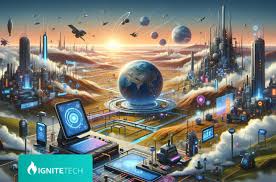Introduction
In 2024, the metaverse continues to evolve as a prominent concept in the realm of digital interaction, blending virtual and augmented realities to create immersive experiences. This expansion is driven by several key technologies that are reshaping how we engage with digital environments. This article explores the technological advancements fueling the growth of the metaverse and examines their implications for various sectors, including gaming, social interaction, and business.
1. Advancements in Virtual Reality (VR) Technology
- Next-Generation VR Headsets
The latest VR headsets in 2024 offer unprecedented levels of immersion and comfort. Companies like Meta, HTC, and Sony have introduced new models with improved resolution, wider field of view, and advanced tracking capabilities. These headsets incorporate higher refresh rates and enhanced spatial audio to create more lifelike virtual environments. For instance, Meta’s Quest Pro 3 features 4K resolution per eye, adaptive optics, and advanced hand-tracking, providing users with a more realistic and engaging VR experience.
- Haptic Feedback and Sensory Technologies
Haptic feedback technology has progressed significantly, adding a new dimension to VR interactions. Advanced haptic gloves and suits simulate touch, texture, and force, allowing users to physically feel virtual objects and environments. Companies like HaptX and bHaptics are leading the way in this space, creating devices that enhance the tactile experience and improve the sense of presence in the metaverse. These innovations make virtual interactions more immersive and intuitive, bridging the gap between the physical and digital worlds.
2. Breakthroughs in Augmented Reality (AR)
- AR Glasses and Wearables
The development of AR glasses and wearables has accelerated in 2024, with devices offering seamless integration of digital information into the physical world. Products like Apple’s Vision Pro and Microsoft’s HoloLens 3 combine high-resolution displays with advanced spatial computing to overlay digital content onto real-world scenes. These AR devices are designed to be lightweight and stylish, enabling users to access information, communicate, and interact with virtual elements without disrupting their daily activities.
- Spatial Computing and Real-Time Data Overlay
Spatial computing technology allows for the real-time overlay of data and interactive elements onto physical spaces. Innovations in computer vision, machine learning, and sensor fusion enable AR systems to accurately map and understand the physical environment, providing users with contextual information and interactive features. For example, AR applications in retail use spatial computing to project product information and virtual try-ons, enhancing the shopping experience and helping consumers make informed decisions.
3. Blockchain and Decentralized Platforms
- Digital Ownership and NFTs
Blockchain technology plays a crucial role in the metaverse by enabling digital ownership and the creation of non-fungible tokens (NFTs). NFTs provide a way to represent ownership of virtual assets, such as digital art, virtual real estate, and in-game items. Platforms like Decentraland and The Sandbox utilize blockchain to facilitate transactions and ensure the provenance of digital assets. This technology empowers users to buy, sell, and trade virtual goods securely, fostering a thriving virtual economy.
- Decentralized Metaverse Platforms
Decentralized metaverse platforms leverage blockchain to create open and user-governed virtual worlds. Unlike centralized platforms controlled by a single entity, decentralized metaverses are governed by their communities and operate on decentralized networks. Projects like Somnium Space and Cryptovoxels are at the forefront of this movement, offering users greater control over their virtual experiences and the ability to participate in the development and governance of the metaverse.
4. Artificial Intelligence (AI) Integration
- AI-Powered NPCs and Virtual Assistants
Artificial intelligence enhances the metaverse by enabling more sophisticated non-player characters (NPCs) and virtual assistants. AI-powered NPCs can interact with users in a realistic manner, respond to complex queries, and adapt to user behaviors. These advancements create richer and more dynamic virtual environments, where users can engage with intelligent characters that enhance the overall experience. For example, AI-driven virtual assistants in gaming environments can provide real-time guidance, personalized recommendations, and interactive storytelling.
- Procedural Content Generation
AI-driven procedural content generation is revolutionizing how virtual worlds are created and expanded. Algorithms can automatically generate diverse and complex environments, characters, and scenarios based on predefined parameters. This technology allows for the rapid expansion of virtual worlds and the creation of unique experiences for each user. Platforms like No Man’s Sky have demonstrated the potential of procedural generation, and this approach is increasingly being adopted in the metaverse to offer endless possibilities for exploration and interaction.
5. Future Directions and Implications
- Cross-Platform Integration
The future of the metaverse will likely see greater integration across different virtual and augmented reality platforms. Efforts are underway to create interoperability standards that allow users to seamlessly transition between various virtual environments and interact with assets across different platforms. This cross-platform integration will enhance user experience and foster a more connected metaverse.
- Ethical and Regulatory Considerations
As the metaverse expands, ethical and regulatory considerations will become increasingly important. Issues such as data privacy, digital rights, and content moderation will need to be addressed to ensure a safe and inclusive virtual space. Policymakers, industry leaders, and community members will need to collaborate to develop guidelines and regulations that balance innovation with user protection.
Conclusion
The metaverse expansion in 2024 is driven by advancements in VR and AR technology, blockchain, AI, and decentralized platforms. These technologies are reshaping how we interact with digital environments and offering new opportunities for immersive experiences. As the metaverse continues to evolve, it will be essential to address ethical and regulatory challenges while embracing innovations that enhance user engagement and connectivity.

